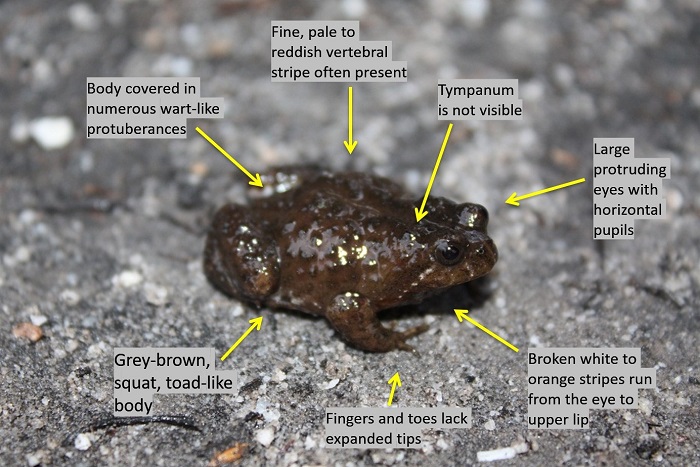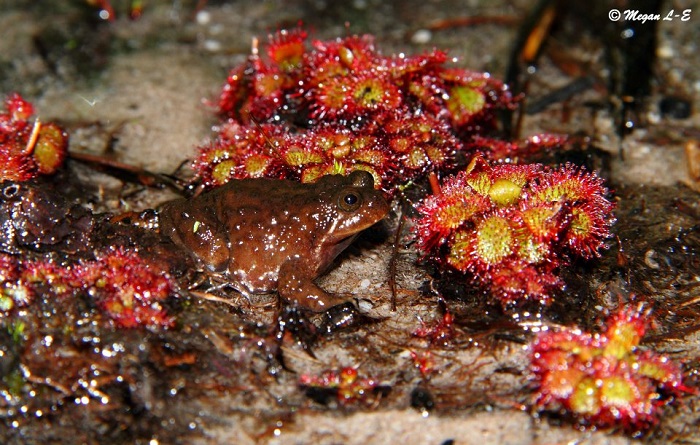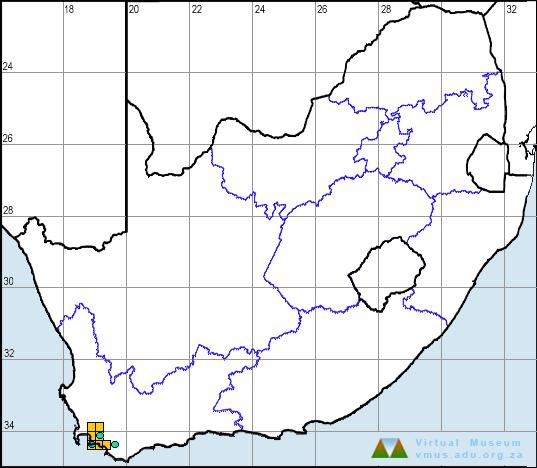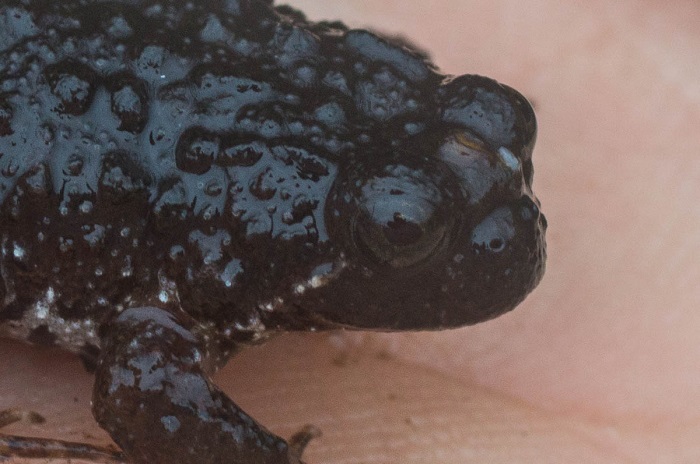View the above photo record (by Christopher Whitehouse) in FrogMAP here.
Find the Marsh Frog in the FBIS database (Freshwater Biodiversity Information System) here.
Family Pyxicephalidae
MARSH FROG – Poyntonia paludicola
Channing and Boycott, 1989
Identification
This species may be confused with the moss frogs, Arthroleptella, that are found in the same habitat. However, P. paludicola is larger, females reaching 30 mm in body length, and has a very granular skin. Behind the eye there is a raised glandular area that resembles the parotoid gland in toads, and a glandular ridge runs from the top of the head to the angle of the jaw. The dorsum is grey-brown, often with a pale vertebral stripe. One to three pale stripes run from the lower margin of the eye to the upper lip. The advertisement call is a harsh chirp, unlike the high-pitched calls of Arthroleptella.

Photo by Felicity Grundlingh
Habitat
This species inhabits marshy areas, shallow seepage zones and shallow streams along rock outcrops in Mountain Fynbos. The rainfall in these areas exceeds 2000 mm p.a., and falls mainly in winter.
Behaviour
Once sufficient rain has fallen to produce shallow flooded areas, the males start to call. Calling may occur at any time of year in suitable weather conditions, but usually takes place from late summer to late winter. Males call from the edge of shallow water and from beneath vegetation in seepage areas (Channing and Boycott 1989). These frogs are beautifully camouflaged when among the mosses that are typical of their habitat.
The tadpoles have long tails and may grow to 32 mm in length. They hide in soft mud.
No records of predators or prey are available.

Photo by Megan Loftie-Eaton
Status and Conservation
Status
P. paludicola is assigned to the category Near Threatened (Harrison et al. 2001; this publication). The species has a restricted extent of occurrence (<5000 km2) and area of occupancy (<500 km2). It is estimated that its habitat had decreased in area by <20% over the last 60 years, and that the population size had declined by <20% over the same period (Harrison et al. 2001). These relatively minor changes may be explained by the species’ occurrence in generally rugged and inaccessible mountainous terrain. The conservation status of this species should be revised once more distribution data and information on habitat preferences and life history are available.
All known populations are located within protected areas, including Hottentots Holland, Maanschynkop, Vogelgat, Jonkershoek and Kogelberg nature reserves and the Kogelberg Biosphere Reserve.
Threats
Present and potential threats include habitat modification by too frequent fires, altered drainage, damming, and the loss of fynbos to agriculture, particularly tree plantations. Habitat fragmentation also poses a significant threat.
Recommended conservation actions
Distribution surveys and population and life-history research are needed for this species. Other recommended measures include habitat management, limiting factor management, and monitoring (Harrison et al. 2001).
Distribution
P. paludicola is endemic to the Cape fold mountains of the southwestern Western Cape Province, where it occurs in two subpopulations (sensu the IUCN definition) in the Hottentots Holland/Kogelberg mountain complex and the Klein River Mountains (Channing and Boycott 1989). It is known from all altitudes between 200 and 1800 m wherever suitable habitat is present. Further fieldwork is expected to extend the known range. The atlas data are accurate but incomplete.

Further Resources
Virtual Museum (FrogMAP > Search VM > By Scientific or Common Name)
More common names: Montane Marsh Frog, Kogelberg Reserve Frog (Alternative English Names); Bergmoeraspadda (Afrikaans)
Recommended citation format for this species text:
Channing A, Tippett RM. Marsh Frog Poyntonia paludicola. BDI, Cape Town.
Available online at http://thebdi.org/2022/02/20/marsh-frog-poyntonia-paludicola/
Recommended citation format:
This species text has been updated and expanded from the text in the
2004 frog atlas. The reference to the text and the book are as follows:
Channing A 2004 Poyntonia paludicola Marsh Frog. In Minter LR
et al 2004.
Minter LR, Burger M, Harrison JA, Braack HH, Bishop PJ, Kloepfer D (eds)
2004. Atlas and Red Data Book of the Frogs of South Africa, Lesotho and
Swaziland. Smithsonian Institution, Washington, and Avian Demography
Unit, Cape Town.

